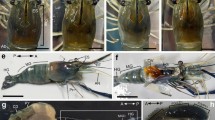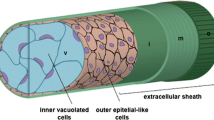Abstract
Hox and ParaHox genes are transcriptional regulators vital for many aspects of embryonic development in bilaterian animals and are considered to have originated from one ancestral proto-Hox/ParaHox cluster. Hox genes are clustered in the genome of both protostomes and deuterostomes, and there is a specific relationship between the position of a gene in the cluster and the position of its expression along the animal body axis (colinearity). It is not clear whether the ParaHox genes Gsx, Xlox, and, Cdx generally exhibit a similar phenomenon since developmental expression for all three ParaHox genes within a single species has not yet been described for any protostome animal. Here we show the spatial and temporal localization for all three ParaHox genes in the polychaete Capitella sp. I, a member of one of the morphologically most diverse and understudied groups within the Metazoa, the Lophotrochozoa. Our data demonstrate that although both CapI-Xlox and CapI-Cdx are regionally expressed in the gut, the three Capitella sp. I ParaHox genes as a group do not perfectly fit predictions of temporal or spatial colinearity. Instead, there is a conservation of expression across species associated with development of particular tissues, and the relative order of initiation of ParaHox gene expression likely reflects the relative order of species-specific tissue development during ontogenesis.



Similar content being viewed by others
References
Brooke NM, Garcia-Fernandez J, Holland PWH (1998) The ParaHox gene cluster is an evolutionary sister of the Hox gene cluster. Nature 392:920–922
Chawengsaksophak K, Beck F (1996) Chromosomal location of cdx2, a murine homologue of the Drosophila gene caudal, to mouse chromosome 5. Genomics 34:270–271
Copf T, Schroder R, Averof M (2004) Ancestral role of caudal genes in axis elongation and segmentation. PNAS 101:17711–17715
de Rosa R, Grenier JK, Andreeva T, Cook CE, Adoutte A, Akam M, Carroll S, Balavoine G (1999) Hox genes in brachiopods and priapulids and protostome evolution. Nature 399:772–776
de Rosa R, Prud’homme B, Balavoine G (2005) Caudal and even-skipped in the annelid Platynereis dumerilii and ancestry of posterior growth. Evol Dev 7:574–587
Duprey P, Chowdhury K, Dressler G, Balling R, Simon D, Guenet J, Gruss P (1988) A mouse gene homologous to the Drosophila gene caudal is expressed in epithelial cells from the embryonic intestine. Genes Dev 12A:1647–1654
Eisig H (1899) Zur Entwicklungsgeschichte der Capitelliden. Mitt Zool Stn Neapel 13:1–292
Ferrier DEK, Holland PWH (2001) Sipunculan ParaHox genes. Evol Dev 3:263–270
Ferrier DEK, Holland PWH (2002) Ciona intestinalis ParaHox genes: evolution of Hox/ParaHox cluster integrity, developmental mode, and temporal colinearity. Mol Phylogenet Evol 24:412–417
Fiedorek F, Kay E (1995) Mapping of the insulin promoter factor 1 gene (IPF1) to distal mouse chromosome 5. Genomics 28:581–584
Gamer L, Wright C (1993) Murine Cdx-4 bears striking similarities to the Drosophila caudal gene in its homeodomain sequence and early expression pattern. Mech Dev 43:71–81
Garcia-Fernandez J (2005) Hox, ParaHox, ProtoHox: facts and guesses. Heredity 94:145–152
Gont L, Steinbeisser H, Blumberg B, de Robertis E (1993) Tail formation as a continuation of gastrulation: the multiple cell populations of the Xenopus tailbud derive from the late blastopore lip. Development 119:991–1004
Holland PWH (2001) Beyond the Hox: how widespread is homeobox gene clustering? J Anat 199:13–23
Hsieh-Li HM, Witte DP, Szucsk JC, Weinstein M, Li H, Potter S (1995) Gsh-2, a murine homeobox gene expressed in the developing brain. Mech Dev 50:177–186
Huelsenbeck JP, Ronquist F (2001) MRBAYES: Bayesian inference of phylogenetic trees. Bioinformatics 17:754–755
Hwang S, Wu J, Chen C, Hui C, Chen C (2003) Novel pattern of AtXlox gene expression in starfish Archaster typicus embryos. Dev Growth Differ 45:85–93
Inoue H, Riggs A, Tanizawa Y, Ueda K, Kuwano A, Liu L, Donis-Keller H, Permutt M (1996) Isolation, characterization, and chromosomal mapping of the human insulin promoter factor 1 (IPF-1) gene. Diabetes 45:789–794
Iwanoff PP (1928) Die Entwicklung der Larvalsegmente bei den Anneliden. Z Morphol Okol Tiere 10:62–161
Kourakis MJ, Martindale MQ (2000) Combined-method phylogenetic analysis of Hox and ParaHox genes of the Metazoa. J Exp Zool 288:175–191
Le Gouar M, Lartillot N, Adoutte A, Vervoort M (2003) The expression of a caudal homologue in a mollusc, Patella vulgata. Gene Expr Patterns 3:35–37
Macdonald P, Struhl G (1986) A molecular gradient in early Drosophila embryos and its role in specifying the body pattern. Nature 324:537–545
Marom K, Shapira E, Fainsod A (1997) The chicken caudal genes establish an anterior–posterior gradient by partially overlapping temporal and spatial patterns of expression. Mech Dev 64:41–52
Matsuo K, Yoshida H, Shimizu T (2005) Differential expression of caudal and dorsal genes in the teloblast lineages of the oligochaete annelid Tubifex tubifex. Dev Genes Evol 215:238–247
McGinnis W, Krumlauf R (1992) Homeobox genes and axial patterning. Cell 68:283–302
Ohlsson H, Karlsson K, Edlund T (1993) IPF1, a homeodomain-containing transactivator of the insulin gene. EMBO J 12:4251–4259
Pillemer G, Epstein M, Blumberg B, Yisraeli J, De Robertis E, Steinbeisser H, Fainsod A (1998) Nested expression and sequential downregulation of the Xenopus caudal genes along the anterior–posterior axis. Mech Dev 71:193–196
Pollard S, Holland PWH (2000) Evidence for 14 homeobox clusters in human genome ancestry. Curr Biol 10:1059–1062
Reece-Hoyes J, Keenan I, Isaacs H (2002) Cloning and expression of the Cdx family from the frog Xenopus tropicalis. Dev Dyn 223:134–140
Ruvkun G, Hobert O (1998) The taxonomy of developmental control in Caenorhabditis elegans. Science 282:2033–2041
Seaver EC, Kaneshige LM (in press) Expression of ‘segmentation’ genes during larval and juvenile development in the polychaetes Capitella sp. I and H. elegans. Dev Biol
Seaver EC, Thamm K, Hill SD (2005) Growth patterns during segmentation in the two polychaete annelids, Capitella sp. I and Hydroides elegans: comparisons at distinct life history stages. Evol Dev 7:312–326
Subramanian V, Meyer B, Gruss P (1995) Disruption of the murine homeobox gene Cdx1 affects axial skeletal identities by altering the mesodermal expression domains of Hox genes. Cell 83:641–653
Swofford DL (2002) PAUP* 4.0: phylogenetic analysis using parsimony (*and other methods). Sinauer, Sunderland, MA
Urbach R, Technau G (2003) Molecular markers for identified neuroblasts in the developing brain of Drosophila. Development 130:3621–3637
Wedeen CJ, Shankland M (1997) Mesoderm is required for the formation of a segmented endodermal cell layer in the leech Helobdella. Dev Biol 191:202–214
Weiss JB, Von Ohlen T, Mellerick DM, Dressler G, Doe CQ, Scott MP (1998) Dorsoventral patterning in the Drosophila central nervous system: the intermediate neuroblasts defective homeobox gene specifies intermediate column identity. Genes Dev 12:3591–3602
Wright C, Schnegelsberg P, De Roberts EM (1989) XlHbox 8: a novel Xenopus homeo protein restricted to a narrow band of endoderm. Development 105:787–794
Wu LH, Lengyel JA (1998) Role of caudal in hindgut specification and gastrulation suggests homology between Drosophila amnioproctodeal invagination and vertebrate blastopore. Development 125:2433–2442
Wysocka-Diller JW, Aisemberg GO, Macagno ER (1995) A novel homeobox cluster expressed in repeated structures of the midgut. Dev Biol 171:439–447
Acknowledgements
This work was supported by NSF (IBN00-94925). We are grateful to members of Kewalo Marine Lab for discussions and comments on the preparation of this manuscript.
Author information
Authors and Affiliations
Corresponding author
Additional information
Communicated by D.A. Weisblat
Rights and permissions
About this article
Cite this article
Fröbius, A.C., Seaver, E.C. ParaHox gene expression in the polychaete annelid Capitella sp. I. Dev Genes Evol 216, 81–88 (2006). https://doi.org/10.1007/s00427-005-0049-0
Received:
Accepted:
Published:
Issue Date:
DOI: https://doi.org/10.1007/s00427-005-0049-0




